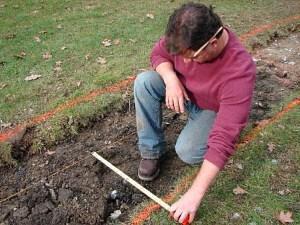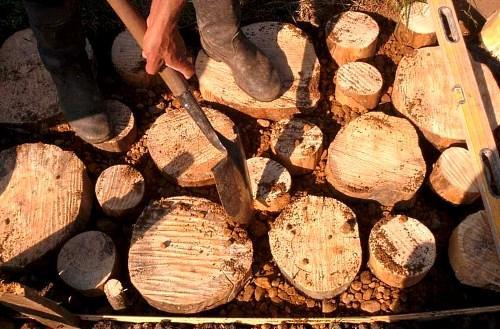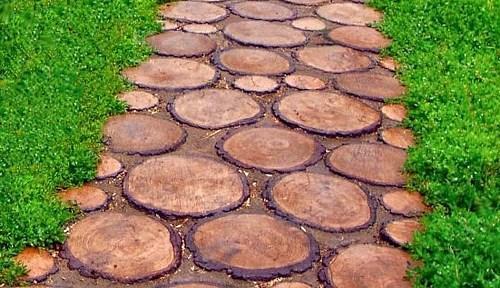How to make a path in the country with your own hands?
 The overall impression of a summer cottage will be incomplete if it is not decorated with beautiful and comfortable garden paths. Not only the appearance of the territory, but also the organization of economic activity depends on how well they are located and well made. Paths in the country can be made of various materials and in different ways.
The overall impression of a summer cottage will be incomplete if it is not decorated with beautiful and comfortable garden paths. Not only the appearance of the territory, but also the organization of economic activity depends on how well they are located and well made. Paths in the country can be made of various materials and in different ways.
The choice of material for the track in the country
Many summer residents ask themselves: what is the best way to make paths in the country? The answer to this question depends on its size and human material capabilities.
Some walkways made from scrap materials look more attractive than traditional ones made of concrete or concrete slabs. Paving in the country should be economical, practical and durable. The material for summer cottages can be very different. Most often, common improvised and building materials are used for their manufacture. In recent years, people are increasingly producing paving slabs ... All materials used for this purpose can be different in color, texture and decorativeness. Most often, they independently make tracks with a tamped surface layer or with a hard surface.

The photo of the tracks in the country house simply amazes the imagination with its diversity. The simplest - rammed paths are made of sand, pebbles, gravel, brick breakage. Some summer residents use wooden cuts to complete this element of the suburban area, which give it a special decorative effect.
For this purpose, only hard wood species treated with special impregnations are used.
Video: making a country path from hemp
The hard surface can be made of brick, natural stone, concrete slabs, paving slabs or in-situ concrete. Various patterns can be made from such material, which will give the site an additional decorative effect. Such a track is much stronger and more durable than rammed ones. It is distinguished by its practicality, but it costs much more than the one that is made from scrap materials.

An important role in creating a path in the country with their own hands is played by a border. It not only fixes clear boundaries, but also protects its edges from destruction. The border also plays a decorative role. While curbstone is a desirable element, it is not considered mandatory. Most often, without a border, paths are made of concrete slabs with large gaps between them and natural stone with a curved configuration of boundaries.
For coatings of sand, pebbles, slag, gravel, a border is necessary. The most practical and durable concrete curb laid on a concrete base. For curved paths, it is better to choose curbs made of bricks, flat stones or tiles, laid on the edge.
By choosing the right material, you can create a harmonious system of tracks, made in the same style and ideally combined with the overall appearance of the site.
- So for decorating a site in a rustic style, a tree is most suitable.
- Natural stone is ideal for making curved paths.
- Brick goes well with buildings made from it. To complete the paths, special types of paving bricks are chosen that are not afraid of moisture and cold.
- Paving stones of different shades allow you to create unique patterns.
- Gravel and pebble paths are most suitable for the garden area and near artificial reservoirs.
In recent years, people have the opportunity not only to create paths from monolithic concrete, but also to give it an original shape. To do this, it will be enough to buy plastic templates of various configurations in a specialized store, which will allow you to cast concrete elements yourself.
Some of the materials used to make the tracks go well together. So they combine perfectly:
- concrete and brick;
- river pebbles and wood;
- multi-colored gravel and natural stone.
Summer cottage planning
Before making paths in the country, it is necessary to correctly draw up a diagram or plan of the site, on which to depict the planned directions, taking into account all the buildings and landings on the site.
When developing them, one should take into account the amount of precipitation that falls in this area. Sometimes it is necessary to create a drainage system so that there is no stagnation of water in the area. It should also be remembered that when it freezes, excess water quickly spoils not only wood, but also materials such as concrete and brick.
Large trees should not grow near paths, as they can destroy them with their powerful roots. When drawing up a more detailed plan-scheme, the picture of the country landscape will be presented more clearly and it will be easier to make a choice in favor of one or another building material.
For almost all types of suburban paths, one technology of their laying is observed. All work is divided into several important stages:
- Site marking. At this stage, the contours of the track are marked with the help of a cord and pegs. The edges are carefully executed along the outlined lines.
- Using a shovel, remove the sod along the length and width of the intended path. The soil is taken out to the thickness of the sand cushion, which serves as the basis for the paving. The thickness of the base layer must be at least 10 cm.
- Sand (sometimes crushed stone) is poured into the dug trench and carefully tamped and leveled.
- Paving is laid on the sand, carefully monitoring the level of the path.

Do-it-yourself budget tracks in the country
The following track options are most popular in the country:
- Gravel or small pebble path. They are made very quickly, but they do not differ in durability. The soil in the trench is treated with herbicides and covered with polyethylene or agrofibre so that weeds do not germinate. A layer of pebbles or gravel is poured onto it and the surface of the path is leveled. In order for this material not to scatter over the site, it is necessary to create a border, for example, from tiles or bricks.
- A path from wood cuts. For its creation, trunks and thick branches of sawn hardwood trees are suitable. They are cut into circles. The thickness of the material should be more than 10 cm. Well-dried cuts are treated with hot drying oil, which is applied with a brush over the entire surface. After the impregnation has dried, the treatment is repeated. A plastic wrap is laid on a previously prepared sand pillow. Cuts are laid on it with any fantasy pattern and level them up. All voids between them are covered with gravel, sand or soil.
- A summer cottage path made of stone can be made not only from purchased material, but also from what can be found in almost any area. When choosing elements, preference should be given to the stone that has at least one flat side. Under such paving, the trench should have a depth of at least 20 cm.Crushed stone (10 cm) is poured onto its bottom. It is tamped, and sand is poured on top (10 cm) and tamped again. Stones are laid on the prepared sand-crushed stone pillow. To fill the voids between them, sand is poured on top and all voids are filled with it. At the final stage, the path is thoroughly watered with water. It may be necessary to re-sand the voids between the stones.
- Cobblestone path.This option is one of the most optimal. The depth of the trench for such material should be 20-25 cm. Sand-crushed stone pillow is created in the same way as under the path for the stone. Paving stones over 60 mm thick will protrude above the soil. This path is best done with curbs. Paving stones are laid on a sandy base tightly to each other. In this case, the pattern can be very diverse. When laying, you cannot use paving stones with signs of marriage, since they will quickly become unusable.
- Brick path. It is created on the same principle as a paving track. The same brick placed on the edge is used as a border. Paving made of bricks of various shades looks especially attractive.

Concrete walkway (video):
Concrete path
Monolithic concrete paths in the country are still popular. For their manufacture, a large amount of cement, sand and crushed stone is required. But they are durable and practical. When performing them, one rule should be remembered: the more cement in the solution, the stronger the concrete will be. For tracks, the following proportions of materials are most often used:
- cement - 1 part;
- crushed stone - 3 parts;
- sand - 2 parts.
In order for such a path to rise above the ground, it is necessary to make formwork from boards under it. At the bottom of the trench, stones, broken bricks or other solid construction waste are laid out. A solution is poured into the formwork and its surface is leveled. Concrete can be decorated with tiles, mosaics or beautiful stones pressed into an uncured mortar.

Tile paths
Walkways made of concrete slabs of various sizes are very popular. They are easy to fit and are distinguished by their durability. A sandy base is also arranged under them. A country path made of tiles 50x50 or 40x40 cm looks quite impressive, does not take up much space and is very practical. By using smaller tiles, different paving patterns can be created. They can be laid close to one another or at some intervals, which are covered with small stones or soil. They can be sown with grass.
At my hacienda, I made about half of the paths of concrete, and the second part of natural stone. Regarding this topic, here's what I would like to note. During their arrangement, a neighbor served me very kindly, prompting me to use fast-setting cement for work, which I bought in the nearest OBI. I took the Master Universal. And this neighbor's tip helped me, that's why. I started making the paths in September, and the concrete, as you know, still has time to stand. Fast-hardening is therefore called that, that the set of strength in it occurs at a higher rate, which was useful in my case. Yes, when concreting, I put a mesh for reinforcement.
I would like to add to the article, thanking the author for the informative material, that in this way you only need to make the main paths and in no case pave the passages between the beds.
In order to maintain order in the aisles between the beds, proceed in three different ways.
1. Throw various plant waste into the aisles: weeds, tops, leaves and cover it all with black non-woven cloth.
2. Sow lawn grass and mow regularly.
3. Fill the passages with slips or small chips.
These measures will allow the passages to be kept in order, and to introduce a considerable amount of organic matter so necessary for our soil.
A detailed article, a wide variety of paths, from anything, not long ago I saw a garden path from rubber tiles, it also looked good, as I understood it, it is fashionable to lay it even without arranging the base.